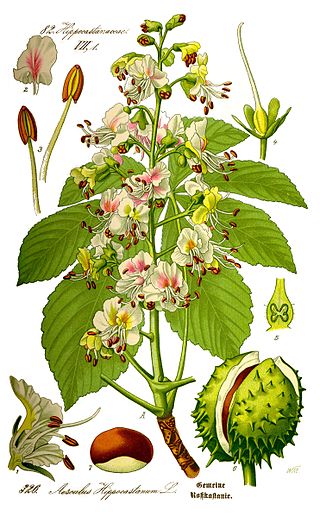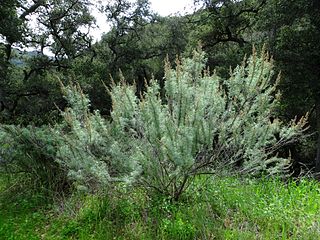
Carpenteria, the tree anemone or bush anemone, is a genus of flowering plants in the hydrangea family Hydrangeaceae. It is closely related to the similar genus Philadelphus and is monotypic, being represented by the single species Carpenteria californica which is a flowering evergreen shrub native to the Sierra Nevada foothills in California.

Umbellularia californica is a large hardwood tree native to coastal forests and the Sierra foothills of California, and to coastal forests extending into Oregon. It is endemic to the California Floristic Province. It is the sole species in the genus Umbellularia.

Aesculus pavia, known as red buckeye or firecracker plant, is a species of deciduous flowering plant. The small tree or shrub is native to the southern and eastern parts of the United States, found from Illinois to Virginia in the north and from Texas to Florida in the south. It is hardy far to the north of its native range, with successful cultivation poleward to Arboretum Mustila in Finland.

The genus Aesculus, with species called buckeye and horse chestnut, comprises 13–19 species of flowering plants in the family Sapindaceae. They are trees and shrubs native to the temperate Northern Hemisphere, with six species native to North America and seven to 13 species native to Eurasia. Several hybrids occur. Aesculus exhibits a classical Arcto-Tertiary distribution.

Quercus agrifolia, the California live oak, or coast live oak, is an evergreen live oak native to the California Floristic Province. Live oaks are so-called because they keep living leaves on the tree all year, adding young leaves and shedding dead leaves simultaneously rather than dropping dead leaves en masse in the autumn like a true deciduous tree. Coast live oaks may be shrubby, depending on age and growing location, but is generally a medium-sized tree. It grows west of the Sierra Nevada mountain range from Mendocino County, California, south to northern Baja California in Mexico. It is classified in the red oak section of oaks.

Quercus wislizeni, known by the common name interior live oak, is an evergreen oak, highly variable and often shrubby, found in many areas of California in the United States continuing south into northern Baja California in Mexico. It generally occurs in foothills, being most abundant in the lower elevations of the Sierra Nevada, but also widespread in the Pacific Coast Ranges—where since 1980 it has been known as a separate species Quercus parvula—and the San Gabriel Mountains. It was named for its collector, Friedrich Adolph Wislizenus (1810–1889).

Quercus douglasii, known as blue oak, is a species of oak endemic to California, common in the Coast Ranges and the foothills of the Sierra Nevada. It is California's most drought-tolerant deciduous oak, and is a dominant species in the blue oak woodland ecosystem. It is occasionally known as mountain oak and iron oak.

Aesculus hippocastanum, the horse chestnut, is a species of flowering plant in the maple, soapberry and lychee family Sapindaceae. It is a large, deciduous, synoecious (hermaphroditic-flowered) tree. It is also called horse-chestnut, European horsechestnut, buckeye, and conker tree. It is not to be confused with the sweet chestnut or Spanish chestnut, Castanea sativa, which is a tree in another family, Fagaceae.

Aesculus glabra, commonly known as Ohio buckeye, Texas buckeye, fetid buckeye, and horse chestnut is a species of tree in the soapberry family (Sapindaceae) native to North America.

The Modoc Plateau lies in the northeast corner of California as well as parts of Oregon and Nevada. Nearly 1,000,000 acres (400,000 ha) of the Modoc National Forest are on the plateau between the Medicine Lake Highlands in the west and the Warner Mountains in the east.

Aesculus flava, also known commonly as the common buckeye, the sweet buckeye, and the yellow buckeye, is a species of deciduous tree in the subfamily Hippocastanoideae of the family Sapindaceae. The species is native to the Ohio Valley and Appalachian Mountains of the Eastern United States. It grows in mesophytic forest or floodplains, generally in acid to circumneutral soil, reaching a height of 20m to 48m.

Abies amabilis, commonly known as the Pacific silver fir, is a fir native to the Pacific Northwest of North America, occurring in the Pacific Coast Ranges and the Cascade Range. It is also commonly referred to in English as the white fir, red fir, lovely fir, amabilis fir, Cascades fir, or silver fir. The species name is Latin for 'lovely'.

Frangula californica is a species of flowering plant in the buckthorn family native to western North America. It produces edible fruits and seeds. It is commonly known as California coffeeberry and California buckthorn.

Aralia californica, known by the common name elk clover though not actually a clover, is a large herb in the family Araliaceae, the only member of the ginseng family native to California and southwestern Oregon. It is also called California aralia and California spikenard.

Artemisia californica, also known as California sagebrush, is a species of western North American shrub in the sunflower family.

California oak woodland is a plant community found throughout the California chaparral and woodlands ecoregion of California in the United States and northwestern Baja California in Mexico. Oak woodland is widespread at lower elevations in coastal California; in interior valleys of the Coast Ranges, Transverse Ranges and Peninsular Ranges; and in a ring around the California Central Valley grasslands. The dominant trees are oaks, interspersed with other broadleaf and coniferous trees, with an understory of grasses, herbs, geophytes, and California native plants.

Malosma is a plant genus which contains only a single species, Malosma laurina, with the common names laurel sumac and lentisco (Spanish). Malosma laurina is found along the southern California and Baja California coasts of the Pacific Ocean.

Festuca californica is a species of grass known by the common name California fescue.

Orcuttia is a genus of grass in the family Poaceae. Plants grow up to 20 cm (8 in) tall, usually with many stems emerging from the base of the plant, and forming a tuft. The spikelets are several-flowered, with reduced upper florets. The lemma tips have between two and five teeth.





























